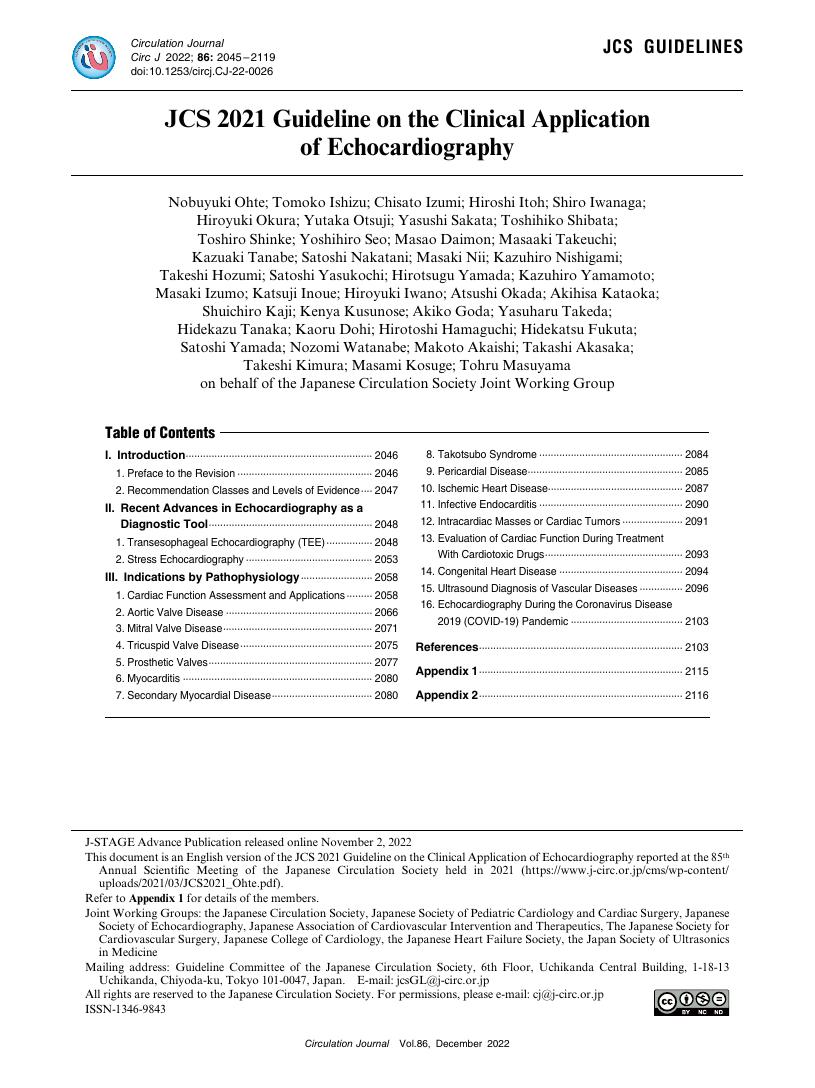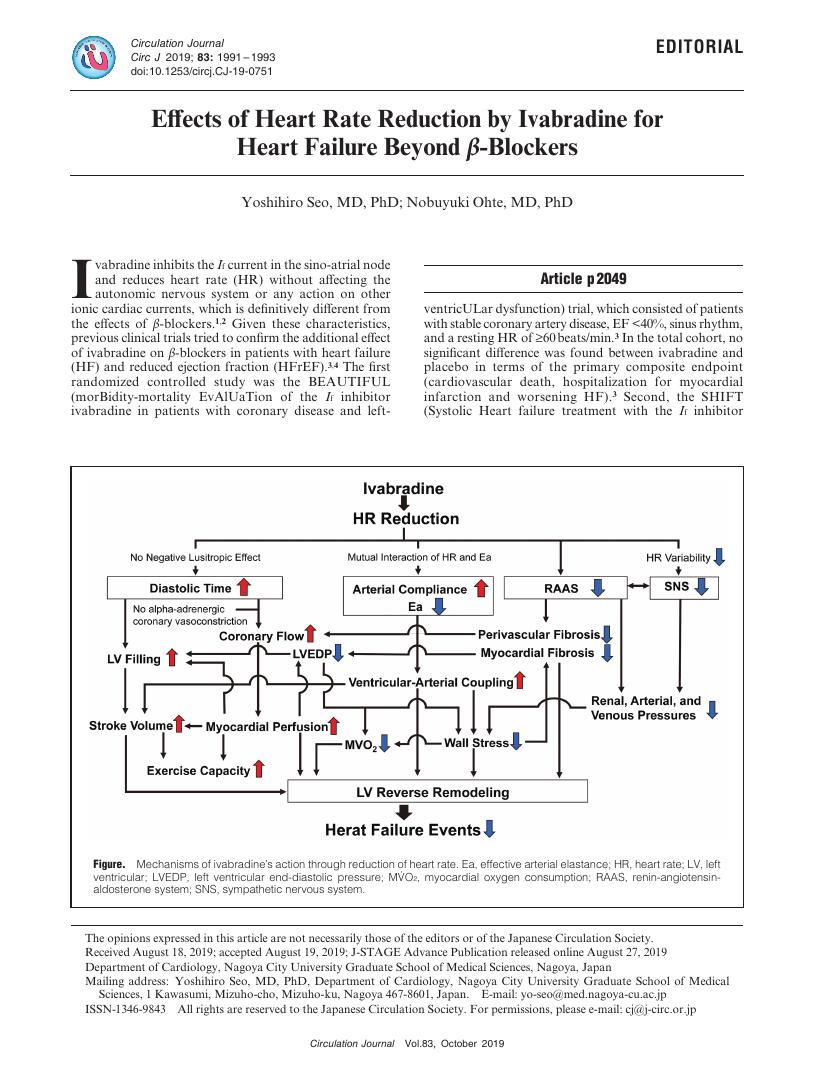25 0 0 0 OA Superiority of Long-Acting to Short-Acting Loop Diuretics in the Treatment of Congestive Heart Failure
- 著者
- Tohru Masuyama Takeshi Tsujino Hideki Origasa Kazuhiro Yamamoto Takashi Akasaka Yutaka Hirano Nobuyuki Ohte Takashi Daimon Satoshi Nakatani Hiroshi Ito
- 出版者
- The Japanese Circulation Society
- 雑誌
- Circulation Journal (ISSN:13469843)
- 巻号頁・発行日
- vol.76, no.4, pp.833-842, 2012 (Released:2012-03-23)
- 参考文献数
- 30
- 被引用文献数
- 46 49
Background: Diuretics are the most prescribed drug in heart failure (HF) patients. However, clinical evidence about their long-term effects is lacking. The purpose of this study was to compare the therapeutic effects of furosemide and azosemide, a short- and long-acting loop diuretic, respectively, in patients with chronic heart failure (CHF). Methods and Results: In this multicenter, prospective, randomized, open, blinded endpoint trial, we compared the effects of azosemide and furosemide in patients with CHF and New York Heart Association class II or III symptoms. 320 patients (160 patients in each group, mean age 71 years) were followed up for a minimum of 2 years. The primary endpoint was a composite of cardiovascular death or unplanned admission to hospital for congestive HF. During a median follow-up of 35.2 months, the primary endpoint occurred in 23 patients in the azosemide group and in 34 patients in the furosemide group (hazard ratio [HR], 0.55, 95% confidence interval [CI] 0.32-0.95: P=0.03). Among the secondary endpoints, unplanned admission to hospital for congestive HF or a need for modification of the treatment for HF were also reduced in the azosemide group compared with the furosemide group (HR, 0.60, 95%CI 0.36-0.99: P=0.048). Conclusions: Azosemide, compared with furosemide, reduced the risk of cardiovascular death or unplanned admission to hospital for congestive HF. (Circ J 2012; 76: 833-842)
- 著者
- Nobuyuki Ohte Tomoko Ishizu Chisato Izumi Hiroshi Itoh Shiro Iwanaga Hiroyuki Okura Yutaka Otsuji Yasushi Sakata Toshihiko Shibata Toshiro Shinke Yoshihiro Seo Masao Daimon Masaaki Takeuchi Kazuaki Tanabe Satoshi Nakatani Masaki Nii Kazuhiro Nishigami Takeshi Hozumi Satoshi Yasukochi Hirotsugu Yamada Kazuhiro Yamamoto Masaki Izumo Katsuji Inoue Hiroyuki Iwano Atsushi Okada Akihisa Kataoka Shuichiro Kaji Kenya Kusunose Akiko Goda Yasuharu Takeda Hidekazu Tanaka Kaoru Dohi Hirotoshi Hamaguchi Hidekatsu Fukuta Satoshi Yamada Nozomi Watanabe Makoto Akaishi Takashi Akasaka Takeshi Kimura Masami Kosuge Tohru Masuyama on behalf of the Japanese Circulation Society Joint Working Group
- 出版者
- The Japanese Circulation Society
- 雑誌
- Circulation Journal (ISSN:13469843)
- 巻号頁・発行日
- vol.86, no.12, pp.2045-2119, 2022-11-25 (Released:2022-11-25)
- 参考文献数
- 460
- 被引用文献数
- 16
- 著者
- Tomonori Sugiura Yasuaki Dohi Yasuyuki Takagi Takashi Yokochi Naofumi Yoshikane Kenji Suzuki Takamasa Tomiishi Takashi Nagami Mitsunori Iwase Hiroyuki Takase Nobuyuki Ohte Yoshihiro Seo
- 出版者
- Japan Atherosclerosis Society
- 雑誌
- Journal of Atherosclerosis and Thrombosis (ISSN:13403478)
- 巻号頁・発行日
- pp.63368, (Released:2022-02-03)
- 参考文献数
- 49
- 被引用文献数
- 5
Aims: Serum uric acid increases with metabolic disorders; however, whether the effects of uric acid on atherosclerosis are different in females and males has not been sufficiently evaluated. Therefore, this study compared the impact of uric acid on arterial stiffness and atherosclerosis between females and males. Methods: We enrolled 10196 untreated middle-aged subjects (46±8 years, 3021 females and 7175 males) who underwent periodic health check-ups. Serum uric acid levels were measured and arterial stiffness and atherosclerosis were assessed by the cardio-ankle vascular index (CAVI), carotid intima-media thickness (IMT), and plaque, using ultrasound imaging. Results: Females with increased arterial stiffness (CAVI ≥ 8.0) or carotid plaques had higher uric acid than those without (P<0.0001), but males did not. In multivariable regression analyses including overall participants, uric acid was significantly associated with the CAVI, where sex interacted with uric acid. In sex-specific analyses, uric acid was significantly associated with the CAVI, but not with carotid IMT, in both sexes. However, logistic regression analyses revealed that serum uric acid was independently associated with the presence of carotid plaques in females. The exclusion of subjects with abdominal obesity or metabolic syndrome from the analysis did not alter the results in females. Conclusions: Serum uric acid was significantly associated with the CAVI in both sexes, but the interaction of sex was confirmed and associated with a carotid plaque only in females. These findings support the increased impact of serum uric acid on arterial stiffness and atherosclerosis in females.
- 著者
- Masaki Ogawa Motoo Nakagawa Masaki Hara Masato Ito Toshihiko Goto Nobuyuki Ohte Yuta Shibamoto
- 出版者
- Annals of Thoracic and Cardiovascular Surgery 編集委員会
- 雑誌
- Annals of Thoracic and Cardiovascular Surgery (ISSN:13411098)
- 巻号頁・発行日
- vol.19, no.1, pp.46-48, 2013-02-20 (Released:2013-02-20)
- 参考文献数
- 5
- 被引用文献数
- 2 10
We report a 64-year-old man with incidentally found uncorrected total anomalous pulmonary venous connection (TAPVC). There have been only a few case reports of untreated TAPVC diagnosed after 60 years of age. Also, this is a first case report of TAPVC in which ECG-gated CT and phase-contrast cine magnetic resonance imaging (PC-MRI) was performed. He was referred to our hospital for the surgery of rectal cancer. He had been diagnosed to have an arterial septal defect (ASD) and persistent left superior vena cava (PLSVC), and Eisenmenger’s syndrome was thought to be the cause of cyanosis at first. The vertical vein in TAPVC was initially misdiagnosed as PLSVC on enhanced axial CT images reconstructed with 5-mm slice thickness with gapless. ECG-gated CT and PC-MRI were useful to confirm the diagnosis. The vertical vein in TAPVC is morphologically similar to PLSVC. This kind of abnormality would be somewhat difficult to diagnose on non-ECG-gated CT, and might be misdiagnosed as a large ASD and PLSVC.
- 著者
- Yoshihiro Seo Nobuyuki Ohte
- 出版者
- The Japanese Circulation Society
- 雑誌
- Circulation Journal (ISSN:13469843)
- 巻号頁・発行日
- vol.83, no.10, pp.1991-1993, 2019-09-25 (Released:2019-09-25)
- 参考文献数
- 15
- 被引用文献数
- 3
- 著者
- Akinori Sawamura Takahiro Okumura Akihiro Hirakawa Masaaki Ito Yukio Ozaki Nobuyuki Ohte Tetsuya Amano Toyoaki Murohara on behalf of the CHANGE PUMP Investigators
- 出版者
- The Japanese Circulation Society
- 雑誌
- Circulation Journal (ISSN:13469843)
- 巻号頁・発行日
- vol.82, no.3, pp.699-707, 2018-02-23 (Released:2018-02-23)
- 参考文献数
- 24
- 被引用文献数
- 2 22
Background:Cardiac recovery and prevention of end-organ damage are the cornerstones of establishing successful bridge to recovery (BTR) in patients with fulminant myocarditis (FM) supported with percutaneous venoarterial extracorporeal membrane oxygenation (VA-ECMO). However, the timing and method of successful BTR prediction still remain unclear. We aimed to develop a prediction model for successful BTR in patients with FM supported with percutaneous VA-ECMO.Methods and Results:This was a retrospective multicenter chart review enrolling 99 patients (52±16 years; female, 42%) with FM treated with percutaneous VA-ECMO. The S-group comprised patients who experienced percutaneous VA-ECMO decannulation and subsequent discharge (n=46), and the F-group comprised patients who either died in hospital or required conversion to other forms of mechanical circulatory support (n=53). At VA-ECMO initiation (0-h), the S-group had significantly higher left ventricular ejection fraction (LVEF) and lower aspartate aminotransferase (AST) concentration than the F-group. At 48 h, the LVEF, increase in the LVEF, and reduction of AST from 0-h were identified as independent predictors in the S-group. Finally, we developed an S-group prediction model comprising these 3 variables (area under the curve, 0.844; 95% confidence interval, 0.745–0.944).Conclusions:We developed a model for use 48 h after VA-ECMO initiation to predict successful BTR in patients with FM.

